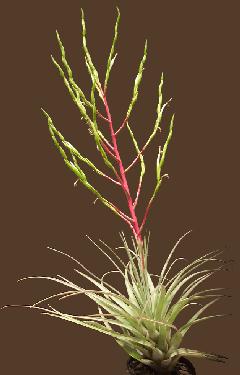
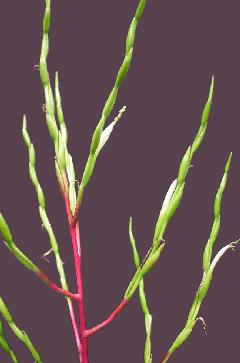
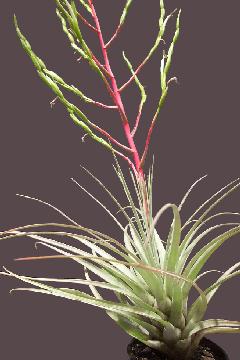
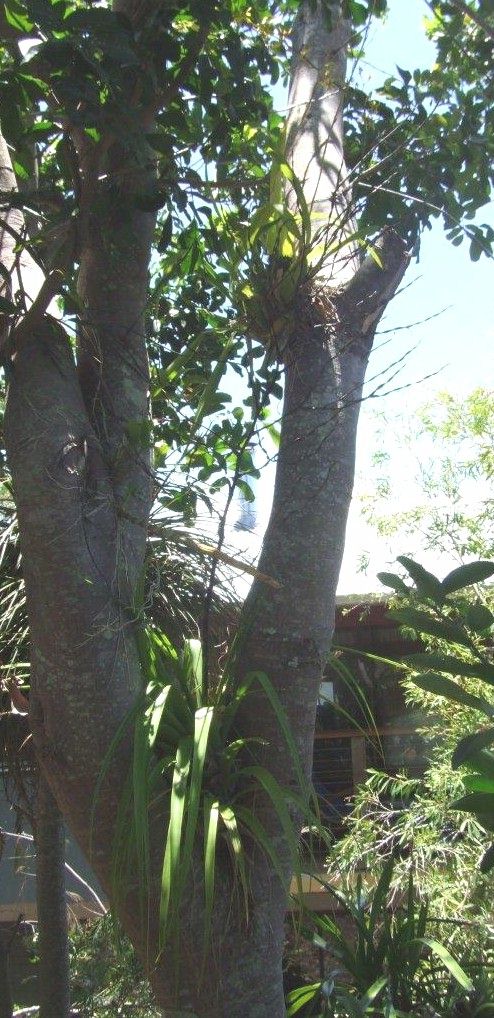
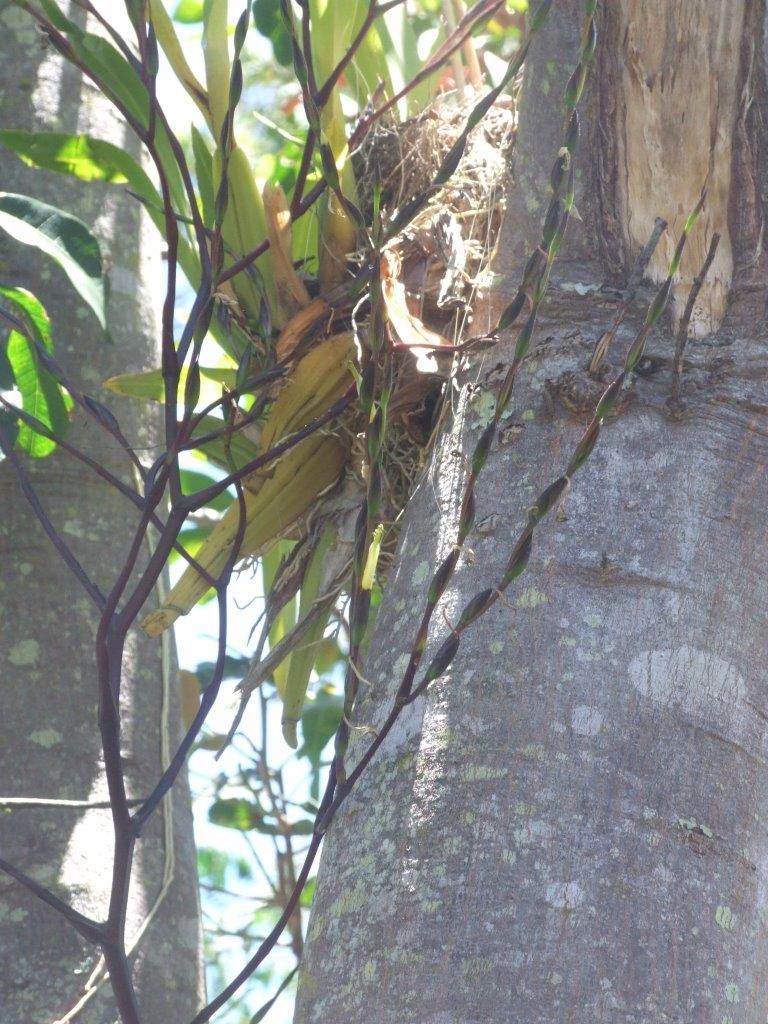
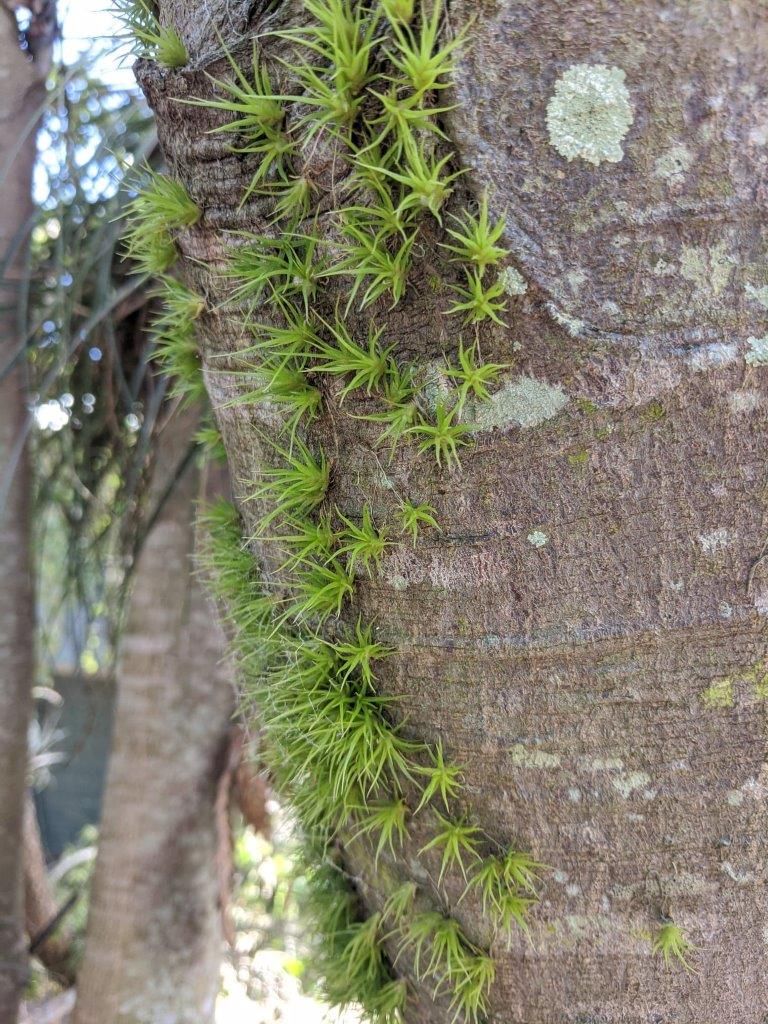
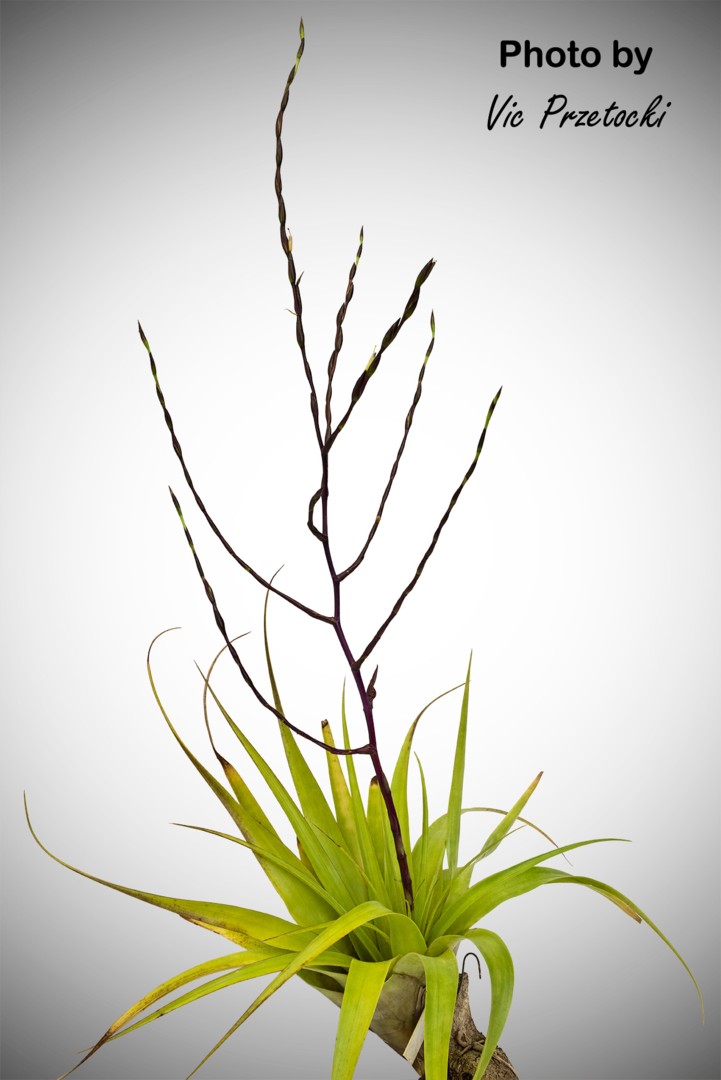
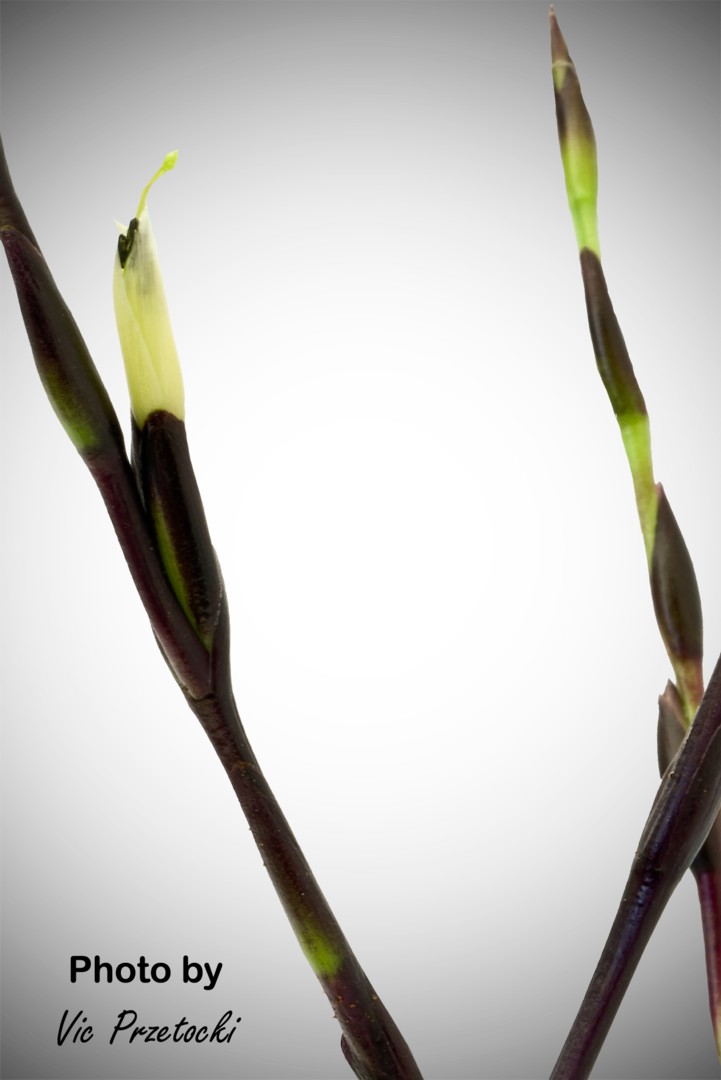
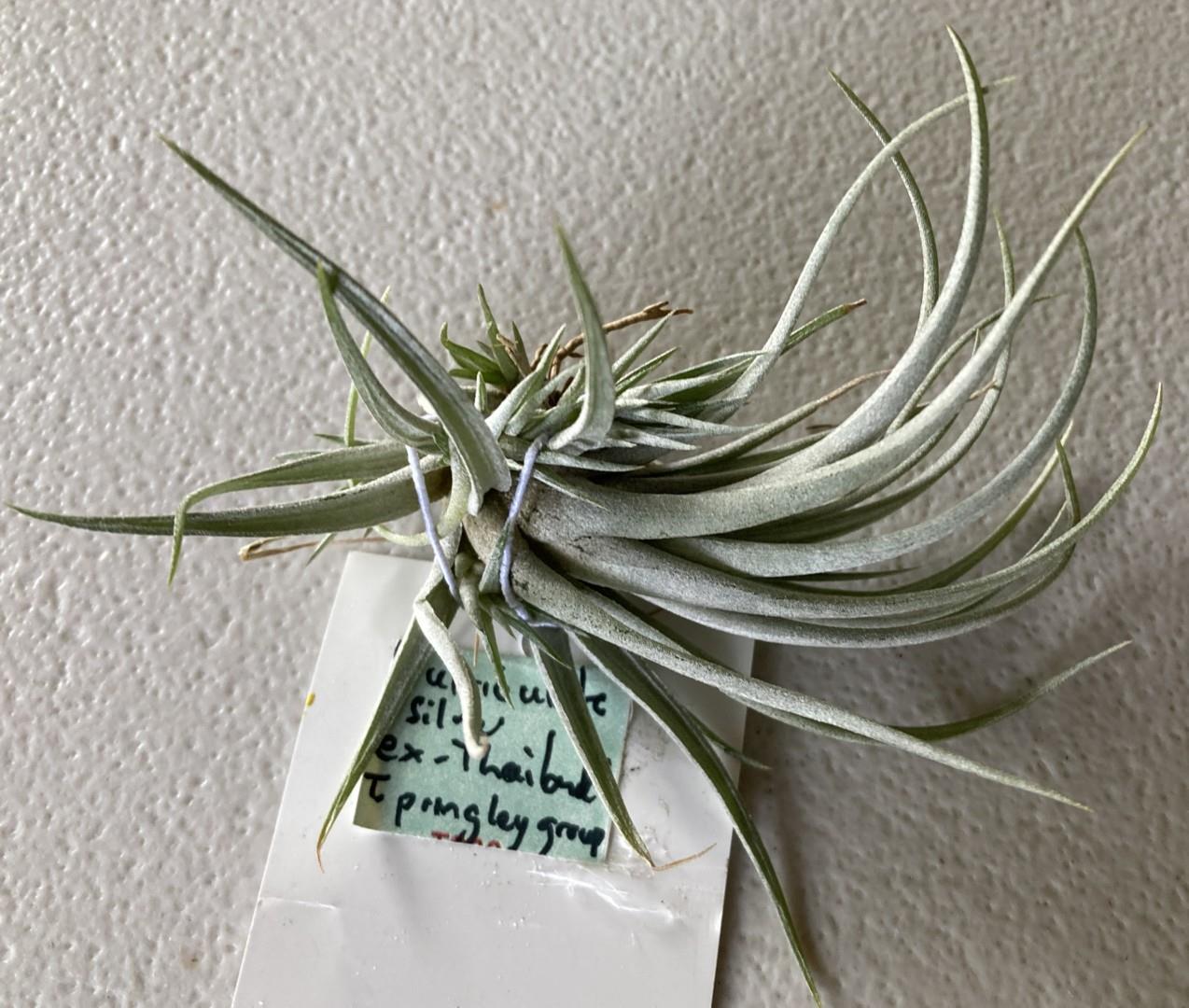
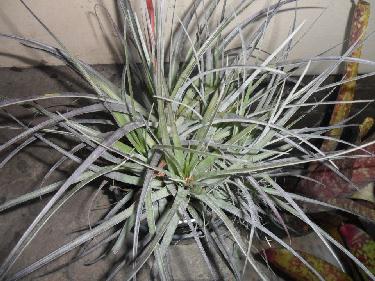
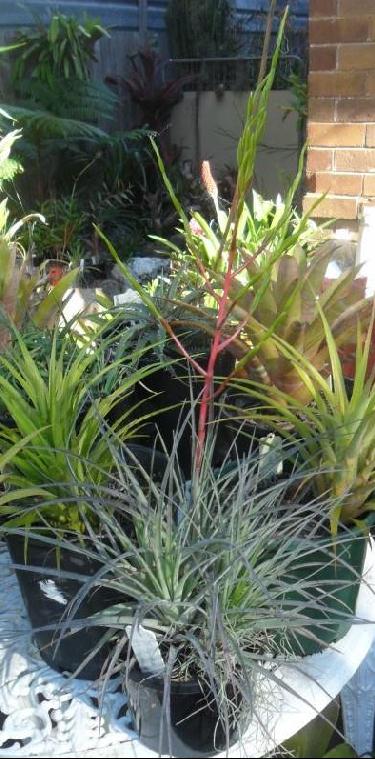
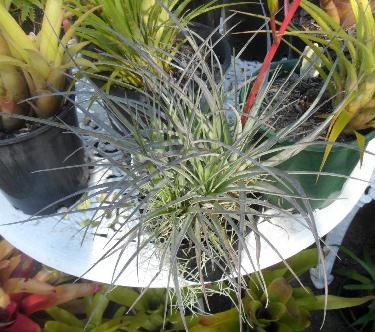
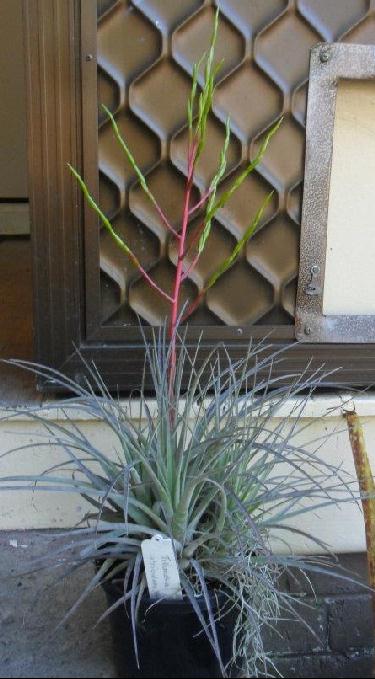
I have been asking some of the experts what the difference is between utriculata and the sub-species pringlei.
It seems the answer is rather muddied amongst taxonomists also ! pringlei has been shuffled all over the place since first mentioned in 1623 !
There have been at least 20 name changes, combinings, seperatings and re-classifications.
Read the following for a current interpretation of the differences, and the various relationships with each other. - Ian Hook.
From the taxonomists...
Linnaeus Sp. Pl. 286. 1753.....
Tillandsia utriculata, subsp. utriculata
?Visci modo arboribus indicis adnascens Bauhin, Pinax 423. 1623.
Description from S&D p971-3.......
Plant stemless, 0.5-2 m high.
Leaves many in a dense utriculate rosette, 4-10 dm long, densely and finely pale-appressed-lepidote throughout;
Sheaths subovate, large;
Blades linear-triangular, long-attenuate, 2-7 cm wide at base, the outer ones usually recurving.
Scape erect, equaling or often exceeding the leaves, stout or slender, glabrous;
Scape-bracts erect, tubular-involute, barely imbricate or the uppermost sometimes remote, ovate, the lower ones linear-Iaminate, the upper acute.
Inflorescence central, amply bi- or tripinnate or rarely simple, lax, glabrous;
Primary bracts like the upper scape-bracts, not more than 4 cm long, much shorter than the sterile base of the axillary branch, often dark violet;
Branches curved-ascending; spiciform racemes to 35 cm long with an elongate sterile base bearing several bracts, laxly flowered; rhachis slender, undulate, sulcate, strongly flattened next the flowers.
Floral bracts erect; enfolding the base of the flower but very little of the rhachis, ovate, obtuse or acutish, much exceeded by the sepals, equaling or shorter than the internodes, closely and prominently nerved throughout, subcoriaceous and green with a broad, membranaceous, often dark purple margin, ecarinate;
Flowers erect, appressed to the rhachis; pedicels stout, to 5 mm long.
Sepals narrowly elliptic or obovate, obtuse, 14-18 mm long, subcoriaceous with a membranaceous margin, prominently nerved;
Petals tubular-erect, linear, acute, 3-4 cm long, white;
Stamens and pistil exserted.
Capsule slenderly cylindric, acute, 4 cm long;
Seed with a long apical appendage.
Type. Sloane s n (BM, GH photo), Jamaica.
DISTRIBUTION. Epiphytic, from near sea level to 1200 m alt, Georgia (Bartram) and Florida, West Indies, Mexico, northern Central America, Venezuela, Florida....
H. Luther, J. Brom. Soc. 28: 165-7. 1978.....
Tillandsia utriculata L. forma variegata
A forma utriculata foliis albo virideque longitudina liter striatus differt.
Type locality: Florida, Manatee County, epiphyte in coastal hammock, collected December 1976
Holotype: US Isotype: SEL
C. S. Gardner Selbyana 7;366-8. 1984.......
Tillandsia utriculata L. subsp. pringlei (Watson)
Tillandsia karwinskyana auct. non Schultes: L. B. Smith & R. J. Downs, Tillandsioideae in Flora Neotropica, Monograph No.14, 1977.
T. pringlei was treated as a synonym of T. utriculata by Mez (1935 ), then transferred to T. karwinskyana by Smith (1951). An examination of living material revealed characters not apparent on dried specimens that support Mez's treatment of T. pringlei within T. utriculata.
Tillandia utriculata subsp. utriculata is a widespread epiphyte of dry, low elevation forests from Florida, through the Caribbean, the Gulf states of Mexico, and Central America into northern South America. Subspecies pringlei is a saxicole in east-central Mexico at elevations between 100 and 1500 meters. The characters that distinguish it from the typical subspecies are characteristics that are often associated with saxicoly or with xerophytic habitats.
Plants in these populations tend to be smaller and less variable in size, and the inflorescences are less highly branched than those in the epiphytic populations. Considerable overlap in these characteristics occurs, however, between the two subspecies (Gardner, 1980). The plants of epiphytic populations are monocarpic, rarely producing offsets after attaining maturity (seedlings often produce basal proliferations) (Benzing and Davidson, 1979; Gardner, 1980, 1983). However, plants in saxicolous populations are polycarpic, forming large clumps (Gardner 1980, 1983). Smith and Downs (1977) used "Leaves covered with coarse cinereous spreading scales, 15-20 cm long; inflorescence few-branched" versus "Leaves covered with minute pale appressed or subappressed scales, to 100 cm long" to separate T. karwinskyana from T. utriculata and a few other species. According to their description, however, T. karwinskyana has "Inflorescence simple or few-branched" and T. utriculata "Inflorescence central, amply bi- or tripinnate or rarely simple."
Indumentum, the remaining character distinction, was found useful in distinguishing these species although some variation was found among populations of T. utriculata. Specimens from populations at the highest elevations tend to be most densely lepidote. The scurfy gray leaves of the most densely lepidote T. utriculata, however, are distinguishable from the tomentose leaves of T. karwinskyana. This characteristic is useful in determining dried specimens. Examination of the trichomes under scanning electron microscopy revealed distinctive surface ornamentation on the ventral surface of the wing cells of T. utriculata that is lacking on those of T. karwinskyana. This characteristic is easily determined under compound light microscopy at magnifications of 100X or greater.
Living, flowering specimens of T. utriculata subsp. utriculata or subsp. pringlei are distinguishable from T. karwinskyana by corolla color and conformation. The corolla of T. karwinskyana is chartreuse, relatively firm, and actinomorphic, although occasionally slightly irregular. That of T. utriculata is thin, creamy white, and the petals twist apically at anthesis forming a lateral aperture and distinct zygomorphy.
Basionym: Tillandsia pringlei Watson, Proc. Am. Acad. 26: 155,1891.
Type: MEXICO: SAN LUIS POTOSI, Las Palmas, Pringle 3530 (GH).
Distribution: Saxicolous on cliffs and boulders of San Luis Potosi, Queretaro, and Hidalgo, Mexico.
Andrew Flower, NZ .... "pringlei is much smaller (plants here are about 15cm high when mature) with thinner, silvery leaves and is "polycarpic" in that it produces offsets after flowering."
Derek Butcher ... "Note the confusion in taxonomist ranks too !
This shows that being monocarpic is not a good way to identify a plant. Some are monocarpic because of growing conditions in your backyard >:-}
It is interesting that it is thought that pringlei offsets like billyo which it does because this is the 'only' form in cultivation because of that habit!
There is also a monocarpic form that nobody bothers to grow."
Chris Larson ... "To qualify Derek's "the one no-one bothers to grow". I talked to someone from the Gold Coast on the weekend who had them all over the place – seedlings everywhere & Peter Tristram has similar issues. Maybe they don’t have to bother – it grows anyway. What a problem to have!
I’d say that the utriculata & utriculata v pringlei IDs are the tip of the iceberg. The size difference is the most obvious between these two, as detailed by Andrew Flower.
However all of the other allied species, many springing up only recently, are considerably more difficult to get your head around. Then there are utriculatas that tend more towards monocarpic tendencies & other clones that are not quite so – often called the pupping clone. Note: monocarpism, in my experience, is a tendency not a principle."
1a. Petals white, cream or green => 2
1b. Petals violet or reddish => 16
2a. Petals white, cream or pale green, lighter than the sepals => 3
2b. Petals apple green => 13
3a. Leaf rosette caulescent => albida
3b. Leaf rosette acaulis => 4
4a. Leaf sheath merging gradually with the blade, which is tomentose lepidote on both sides; wings of the scales without toothed margins; floral bracts and sepals glabrous adaxially; inflorescence simple => 5
4b. Leaf sheath distinct from blade, which is glabrous or adpressed lepidote abaxially; wings of the scales verrucose with crenate or entire margins; floral bracts and sepals lepidote adaxially; inflorescence usually paniculate => 6
5a. Floral bracts abaxially glabrous, with a rounded tip; flowers adpressed to the rachis. Nuevo Leon, San Luis Potosi => karwinskyana
5b. Floral bracts sparsely lepidote abaxially, with an acute or obtuse tip; the flowers are slightly separated from the rachis. Zacatecas, Jalisco => fresnilloensis
6a. Polycarpic with many basal offsets; leaf blade densely lepidote on both sides; plant lithophytic => 7
6b. Monocarpic or polycarpic with axillary offsets; leaf blade sparsely lepidote or glabrous adaxially; plant epiphytic => 8
7a. Leaves rigid, tip pungent; leaf blade more than 34 mm wide; inflorescence two or more times divided. Jamaica. => calcicola
7b. Leaves flexible, tip not pungent; leaf blade less than 18 mm wide; inflorescence divided once. Tamaulipas, San Luis Potosi, Queretaro, Hidalgo => pringlei
8a. Polycarpic with axillary offsets; widespreading stigma lobes, not spiralling => 9
8b. Monocarpic; stigma strongly with spiralling lobes => 11
9a. Average length of the floral bracts greater than 23.4 mm; length of the basal floral bracts more than 25.5 mm. On the Caribbean side of Belize to Nicaragua => izabalensis
9b. Average length of the floral bracts below 23.2 mm: length of the basal floral bracts less than 25.3 mm Gulf of Mexico and Yucatan Peninsula => 10
10a. Rosette funnel-shaped; leaves leathery, erect to arching, usually with a pungent tip; axis of the inflorescence and rachis scarlet red or pink; floral bracts scarlet red or green; branches erect to ascending, inserted in the rachis at an angle of about 45 °; occasionally with offsets in the inflorescence. Peninsula of Yucatan, Tabasco, Belice, Guatemala => dasyliriifolia
10b. Rosette open; leaves flexible, recurved, tips not pungent; axis of the inflorescence and rachis carmine red violet-tinged; floral bracts violet-tinged; branches curved ascending, inserted in the rachis at an angle of about 90 °; offsets never present inflorescence. San Luis Potosi, Hidalgo, Puebla, Veracruz, Tabasco, Oaxaca, Chiapas. => limbata
11a. Petals oblong with rounded tip; Anthers more than 3.8 mm long; average width of the floral bracts more than 6.1 mm; average width of the rachis more than 2.7 mm => comitanensis
11b. Petals spatulate with an acute tip; Anthers less than 3.6 mm long; average width of the floral bracts less than 5.9 mm; average width of the rachis less than 2.6 mm => 12
12a. Flowers of more than 56 mm long (including the pistil); inflorescence divided once; axis of the inflorescence and rachis rose; average proportion length of internode of the rachis to the length of the floral bract, less than one. North-west of the Valle Central of Chiapas => elusiva
12b. Flowers less than 52 mm in length (including the pistil); inflorescence usually twice divided; axis of the inflorescence and rachis green, scarlet red or dark violet; average proportion length of internode of the rachis to the length of the floral bract, greater than or equal to one. Florida, side of the Gulf of Mexico, Caribbean side of Mexico to Costa Rica, the Antilles, North Venezuela => utriculata
13a. Leaf sheath indistinct from the blade which is tomentose lepidote on both sides; leaf blade width less than 16 mm; wings of the scales without toothed margins; floral bracts and sepals glabrous adaxially; inflorescence simple => 5
13b. Leaf sheath distinct from the blade which is adpressed lepidote abaxially and glabrous or adpressed lepidote adaxially; width of blade greater than 17 mm; wings of the scales verrucose with crenate or entire margins; floral bracts and sepals lepidote adaxially; inflorescence commonly paniculate => 14
14a. Polycarpic with axillary offsets; leaves flexible; blades ribbed inconspicuously abaxially with scales distributed evenly on surface; stigma with extended lobes, not spirally. Caribbean side of Belize to Nicaragua => izabalensis
14b. Monocarpic or polycarpic with basal offsets; leaves leathery to rigid; blades conspicuously ribbed abaxially, with scales distributed in rows in the valleys of the nerves; stigma with erect to slightly spiralled lobes. Pacific Ocean side, Jalisco (Mexico) to Puntarenas (Costa Rica) => 15
15a. Anthers more than 5 mm long; leaves with coriaceous consistency, the more basal blades pendulous, floral bracts glaucous abaxially; petals with tip erect or slightly divergent; plants to the south of Oaxaca => huamelulaensis
15b. Anthers less than 4.5 mm long; leaves with rigid brittle consistency, the more basal blades arched or erect; floral bracts bright abaxially; petals with slightly incurved tip; plants of the Pacific Ocean side, Jalisco (Mexico) to Puntarenas (Costa Rica) => cucaensis
16a. Floral bracts densely lepidote abaxially; plant lithophyte => socialis
16b. Floral bracts glabrous abaxially; plant epiphyte => 17
17a. Leaves flexible, soft, tip not pungent. Valley of Tehuacan - Cuicatlan and areas adjacent => tehuacana
17b. Leaves firm to rigid, tip pungent. Pacific side and mountain ranges in the West, Centre and South Mexico areas => 18
18a. Axis of the inflorescence, rachis, floral bracts and tip of the sepals red wine coloured; average length of the floral bracts greater than or equal to 3 times the width; petals more than 40 mm long, red, tip erect or slightly divergent; Anthers more than 3.5 mm long => nicolasensis
18b. Axis of the inflorescence and rachis scarlet red or magenta color; floral bracts and tips of sepals scarlet red or red wine coloured, with or without violet tints; average length of the floral bracts less than 3 times the width; petals less than 39 mm long, without reddish tints, slightly incurved tip; Anthers less than 3.5 mm long => 19
19a. Rosette funnel shaped, higher than wide, average length of the floral bracts greater than 14.6 mm, petals more than 35 mm long. Central, Southern and Western Mexico, West of the Isthmus of Tehuantepec => makoyana
19b. Rosette about the same height and width; average of the length of the floral bracts less than 13.6 mm; petals less than 31 mm long. East of Oaxaca => pinicola
Tillandsia utriculata L., Sp. Pl. 1: 286. 1753. See Pinzon et al in Ann. Missouri Bot. Gdn. 104(2): 262-323. 2019
Platystachys utriculata (L.) Beer, Fam. Bromel. 266. 1856.
Vriesea utriculata (L.) Regel, Index Seminum (St. Petersburg) 34. 1870.
TYPE: Jamaica. St. Ann Parish: Middlesex Co., Cole Gate, ca. 4 mi. S of Ocho Rios, epiphyte on small tree along roadside, 210 m, 20 Aug. 1992, W. Till 9014 (neotype, designated by W. Till in Jarvis et al. {1993: 94}, WU!; isoneotype, BM image!, SEL not seen). Figure 36.
Tillandsia flexuosa Sw. ? pallida Lindl., Bot. Reg. 9: t. 749. 1823.
Anoplophytum flexuosum (Sw.) Beer var. pallidum (Lindl.) Beer, Fam. Bromel. 43. 1856. TYPE: West Indies and South America (holotype, t. 749 in Lindley {1823}!).
Platystachys ehrenbergii K. Koch, Index Sem. (Berlin) 4: 5. 1873 {1874}.
TYPE: United States. Virgin Islands: St. Thomas, 1826–1828, C. A. Ehrenberg 214 (syntype, HAL!).
Allardtia potockii Antoine, Oesterr. Bot. Z. 28: 56. 1878.
TYPE: Carolina? (holotype, icon. in Antoine {1878: betw. pp. 56 & 57}!).
Tillandsia ramosa Bello, Anales Soc. Esp. Hist. Nat. 12: 121. 1883.
TYPE: United States. Puerto Rico: Aguada in arboribus, Rio Grande, 18 Dec. 1886, P. E. E. Sintenis 5777 (neotype, designated by Santiago-Valent´in et al. {2015: 342}, P!).
Tillandsia brevibracteata Baker, J. Bot. 25: 346. 1887.
TYPE: France. Martinique: Bois de la Montagne, Dec. 1867?, L. Hahn 524, 578, 680 (syntypes, K!), 578 (syntype, P!).
Tillandsia sintenisii Baker, J. Bot. 26: 12. 1888.
TYPE: United States. Puerto Rico: Prope Cayey, ad arbores sylvae primariae in monte “Torito,” 650 m, 13 Oct. 1885, P. E. E. Sintenis 2134 (syntypes, GH!, K!, LE!, LY not seen, US!, WSRL not seen).
Tillandsia utriculata f. variegata H. Luther, J. Bromeliad Soc. 28: 166. 1978.
TYPE: United States. Florida: Manatee Co., epiphyte in coastal hammock, Dec. 1976, T. R. Pulver s.n. (holotype, US!; isotype, SEL not seen).
Plant epiphytic, acaulescent, monocarpic, or rarely producing basal propagules, 40–200 cm high at flowering, rosette open.
Leaves commonly recurved, sometimes arched, 9.3–31.7 cm;
sheaths elliptical, 14–54 x 11–30 mm, abaxially whitish green, straw-colored in dried plants, smooth, thickly lepidote, scales subcinereous, wings spread, adaxially chestnut to brown, without violet tints, smooth, densely or sparsely lepidote, scales appressed, with inconspicuous wings;
blades narrowly triangular, 2.6–6.7 times longer than the sheath, 22–61 mm wide at the base, abaxially whitish green, smooth or slightly nerved when dry, densely or sparsely lepidote, scales cinereous or subcinereous, evenly distributed, wings extended, adaxially dark green to yellowish green, smooth or finely nerved when dry, sparsely lepidote over the entire surface, or only at the base, and then glabrescent or glabrous toward the middle and apical part, scales with the wings extended or appressed, hyaline, membranous, subcoriaceous, flexible, apex subulate, not pungent;
scales with verrucose ornamentation on the wings, margins entire or crenate.
Peduncle erect, 2.3–10.6 mm wide at the apex, green, red, or dark violet, rigid;
basal peduncle bracts foliose, abaxially green, smooth or finely nerved when dry, sparsely lepidote, imbricate, blade arched, apex subulate or acuminate, apical ones triangular or ovate-lanceolate, abaxially green, with or without red or purplish tints, smooth or finely nerved when dry, glabrous, base amplexicaul or not, apex acuminate or acute, remote.
Inflorescence compound, commonly twice divided;
axis erect or slightly flexuous, 1.8–8.5 mm wide, green, red, or dark violet, smooth, glabrous, subrigid or rigid, internodes 12.3–59 mm long;
primary bracts triangular or ovate-lanceolate, 9.6–139(–149) mm long, abaxially green with or without red or purplish tints, smooth, glabrous, adaxially lepidote, apex acuminate to acute;
branches ascending, erect or slightly arched upward, 7.3–49.9 cm long, with a basal sterile area of 16–225mm long;
rachis slightly flexuous, with the area adjacent to the flowers flat, 0.6–2.4 mm wide in the medial part, green, red, or dark violet, glabrous, internodes 8.7–34.4 mm long;
floral bracts ovate or ovate-lanceolate, 9.3–25.7 mm long by 2–5.9 mm wide when folded in half lengthwise, on average shorter than the internodes of the rachis, abaxially green or tinted reddish or dark violet, nerved when dry, glabrous, adaxially densely punctulate-lepidote, base partially amplexicaul, apex acute or obtuse, margins hyaline, ecarinate, papyraceous.
Flowers distichous, 44–51.9 mm, appressed to the rachis, sessile;
Sepals spatulate, 13–27.3 mm long, 6.5–8 mm wide, abaxially green, with or without dark red or violet tints at the apex, nerved when dry, glabrous, adaxially densely punctulate-lepidote, apex rounded or obtuse, margins hyaline, ecarinate, papyraceous;
corolla tubular, zygomorphic, spiraled to the height of the apex of the ovary;
petals spatulate, 29–34.8 x 5–7 mm, white or cream, apex acute, connivent or slightly recurved, margins not hyaline;
stamens exserted, in 2 series of different length;
filaments 37–47.5 mm, of the same width along their entire length, round in cross-section, pale green;
anthers oblong, subbasifixed, versatile, black;
style exserted 37–46 mm, longer than the stamens, pale green;
stigma green, lobes conduplicate, strongly spiral, papillose.
Capsules subfusiform, 25.5–51.5 mm long, brown externally, internally shiny black, smooth, apex mucronate.
Seeds spindle-shaped, brown, with 2 feathery appendages, the apical shorter than the body of the seed, the basal long and comose.
Etymology. The specific epithet comes from utriculus (small water bag), due to the accumulation of water in the tank, formed by the sheaths of the leaves.
Phenology. Flowering occurs in January to March, May, June, August, and November. Fruiting occurs in January to March, May, July, August, October, and November.
Distribution and ecology. Tillandsia utriculata is the most widely distributed of this complex, occupying the peninsula of Florida (U.S.A.), the Bahamas, Greater Antilles, and Minor Antilles, north Venezuela, Mexico (in the states of Veracruz, Oaxaca, Tabasco, Chiapas, Campeche, Yucatan, and Quintana Roo), Belize, and the Caribbean coast from Guatemala, Honduras, Nicaragua, and Costa Rica (Fig. 37). Its distribution is the biogeographic provinces of Austroriparia and the Everglades in Florida (Udvardy, 1975), as well as the biogeographic provinces of the Bahamas, Cuba, Jamaica, Hispaniola, Puerto Rico, Lesser Antilles, Trinidad and Tobago, Venezuelan coast, Sierra Madre del Sur, Gulf of Mexico, Yucatan Peninsula, and eastern Central America (Morrone, 2001, 2005). This species has a wide ecological distribution, found in a temperate humid climate in Florida or in humid or subhumid warm climates in the rest of its distribution, and even in arid climates in the northeast of the Yucatan Peninsula. It is found in coastal scrub, dry and wet rainforests, mountain cloud forest, holm-oak woods and wetlands, at altitudes between 0 and 1350 m.
Discussion. As mentioned previously, the species most related to Tillandsia utriculata are T. calcicola, T. pringlei, and T. elusiva (Pinzon et al., 2016). All of them share the same floral pattern, with the corolla zygomorphic, slightly spiraled to the height of the apex of the ovary and the apex of the acute petals and strongly coiled stigma. They can, however, be distinguished in the herbarium. Tillandsia calcicola is a lithophyte with leaves white-lepidote on both surfaces, rigid, and pungent, whereas T. utriculata is an epiphyte with leaves flexible, not pungent, green, and glabrous or glabrescent adaxially. Tillandsia pringlei is separated from T. utriculata by its polycarpic property and leaves that are densely lepidote on both surfaces; they also tend to be smaller. According to data analyzed, the leaf blade of T. pringlei (at its base) can measure up to 17 mm, in contrast to T. utriculata, for which the lowest value was 22 mm. In addition the primary bracts of T. pringlei are sparsely lepidote while those of T. utriculata are glabrous. Tillandsia elusiva is another related and very similar species but differs in the herbarium because the bracts are, on average, longer than the internodes of the rachis, while in T. utriculata they are shorter; in living specimens, T. elusiva has an inflorescence tinted pink, while in T. utriculata the inflorescence can be green or tinted red or violet, never pink when the plant is found in anthesis.
Tillandsia utriculata is another of the most variable species of this complex, ranging from small plants with inflorescences little branching to plants up to 2 m tall with inflorescences profusely branched, up to three times divided. The rosette can be open, with leaves recurved, dark green, mainly in individuals growing in mesic or shaded areas, or may have infundibuliform rosettes, with leaves arched, abaxially silver and adaxially yellowish in individuals exposed to the sun. The color of the inflorescence is also variable: populations in Florida, the Bahamas, and the Lesser Antilles, for example, generally have a completely green inflorescence; the populations of the northwestern Yucatan Peninsula, Cuba, and Dominican Republic tend to have inflorescences tinted red, while the populations of continental wetlands, from Oaxaca to Costa Rica, as well as Venezuela, have inflorescences usually tinted a dark purplish color. There are a few atypical specimens coming from Puerto Rico, the U.S. Virgin Islands, Guadeloupe, and St. Lucia (Duchassaing s.n., C. N. Eggers s.n., L. Rodriguez 4269, Ledru s.n., Riedle s.n., and R. A. Howard et al. 19948), deposited in herbaria P or GH, that have the foliar sheaths undifferentiated from the blades and these are stiff and white-lepidote on both surfaces; in addition, the floral bracts tend to be longer than the internodes of the rachis. Probably these specimens represent a different taxon from Tillandsia utriculata, but it is not possible to make a taxonomic decision without observing plants in the field, including the flowers, which are important to define the species in this group.
The description of Tillandsia utriculata is accompanied by the diagnosis by Linnaeus, “culmo paniculato,” without reference to any specimen (Linnaeus, 1753: 286). However, the diagnosis refers to four polynomials, actually published. The oldest, “Visci modo arboribus indicis adnascens,” comes from Pinax Theatri Botanici of Bauhin (1623). Chronologically, the other three are from the Sloane catalog (1696), from Nova Plantarum Americanarum Genera by Plumier (1703), and from Hortus Cliffortianus (Linnaeus, 1737). Of all of them, only the Plumier and the Sloane references have some associated specimen or illustration. Plumier cites t. 33, but the illustration refers to the genus Caraguata and not to the specific polynomial cited by Linnaeus; therefore, the illustration cannot be used as type. Sloane’s polynomial is the only one which could be associated with a type specimen, as explained below. The Sloane polynomial is as follows: “Viscum Caryophylloides maximum, flore tripetalo pallide luteo, semine filamentoso” (Sloane, 1696: 76). This polynomial and the catalog reference page is cited on a specimen in the Sloane Herbarium (BM), bound in volume 3, on page 98, where the herbarium shows an inflorescence of Tillandsia balbisiana Schult. & Schult. f. The illustration on page 98 verso shows a sketch that corresponds, broadly speaking, with T. utriculata in the current circumscription and belongs to the same specimen on the front of page 98 because it has the legend “idem cum praeced.” On page 99 there is an illustration that is undoubtedly T. utriculata, although there is no legend that links this illustration with the previous specimen, so they cannot be considered the same.
The annotation by Sloane says “The Wild Pine vid. descript.” Page 100 is a herbarium sample of a spike, also undoubtedly of T. utriculata, which links to the illustration on page 99 with the legend “idem cum praeced”; thus, the illustrations on pages 99 and 100 represent the same specimen. According to information in the Sloane Herbarium provided by the Natural History Museum, specimens are roughly in the order of publication used in the catalog. Therefore, specimens immediately before and after those on page 98 of volume 3 of the herbarium should correspond with those immediately before and after the polynomials in the catalog. The specimen on page 97 in volume 3 of the herbarium makes reference to the polynomial “Sagitta. Cast. Durant.” and refers to page 76 of the catalog, therefore corresponds to the polynomial preceding “Viscum Caryophylloides maximum, flore tripetalo...” (Sloane, 1696). On page 101 of volume 3 there is a marked herbarium specimen with the polynomial “Viscum Cariophylloides {sic} maximum,
capitulis in summitate conglomeratis” and a reference to page 77 in the catalog; on this page in the catalog, immediately after the paragraph concerning the polynomial “Viscum Caryophylloides maximum, flore tripetalo...” is the polynomial from page 101 of the herbarium (Sloane, 1696). Because of this, there is evidence that in addition to page 98 verso, pages 99 and 100 of the herbarium correspond with the polynomial
“Viscum Caryophylloides maximum, flore tripetalo...”; however, as the page 98 verso is not linked with 99 or 100 by any other indication, it cannot be confirmed they are all the same specimen. While considering pages 98 and 98 verso as the unique polynomial associated with “Viscum Caryophylloides maximum, flore tripetalo...,” there might be the possibility to designate it as holotype to the illustration on page 98 verso, which agrees better with the polynomial than the inflorescence of T. balbisiana on page 98, with no pale yellow flowers, but violet. According to article 9.14 of the Code, when a type specimen contains parts pertaining to more than one taxon, the name must remain fixed to the part which most closely corresponds with the original description or diagnosis. Therefore, it would be possible to attach the name to the illustration on page 98 verso and consider it as the lectotype of T. utriculata. In fact, Smith and Downs (1977) saw the Sloane s.n. (BM) specimen as the type of Tillandsia utriculata although not explicitly resolving the problem that implies that there is material of two different species in the same sample. On the other hand, W. Till, when reviewing the specimen Sloane s.n. on p. 98 (BM), designated a neotype from a plant from Jamaica (W. Till 9014, WU) (Jarvis et al., 1993), and therefore implicitly considered that the illustration on page 98 verso is not enough by itself to match unambiguously with the protologue of the polynomial “Viscum Caryophylloides maximum flore tripetalo... .”
Additional specimens examined. ANTIGUA & BARBUDA. Antigua: Fryes Hills N of St. John, 11 June 1950, Howard 11856 (B). BAHAMAS. Andros: South Andros, coppice at W end of Congo Town airstrip, 26 May 1974, Gillis 12048 (GH). Crooked Island: Sun Bluff Rd., 9–23 Jan. 1906, Brace 4694 (GH). Exuma: 1009 inland by Caesar’s Slip, Hummingbird Cay, 4 Jan. 1976, Nickerson 22 (MEXU); back of Sunover Beach, Hummingbird Cay, 16 Jan. 1969, Nickerson & Semple 2969 (A). Rum Key: N of intersection of rd. from Port Nelson to Port Boyd & to Lake George, 8 Mar. 1976, Gillis 13053 (A). COSTA RICA. Alajuela: vic. Quesada, 675 m, 6 July 1991, Berg s.n. (SEL). Cartago: Cant´on de Turrrialba, bosque secundario y ´arboles en potrero en los terrenos del CATIE, 9°539050N, 83°419140W, 710 m, 6 Apr. 1994, Morales &L´epiz 2658 (B, SEL). Lim´on: along rd. 3 km N of Jim´enez off the San Jos´e Lim´on Hwy., 12 July 1992, Grant & Rundell 92-01937 (SEL). CUBA. s. loc.: s.d., de la Sagra s.n. (P); s.d., Wright 3748 (GH). Cienfuegos: Limones, Soledad, 9 Nov. 1928, Jack s.n. (A). Villa Clara: Belmonte, Soledad, Cienfuegos, 2 Feb. 1928, Jack 6387 (A, GH); Soledad, Cienfuegos, 31 Jan. 1930, Jack 7615 (A); Caunao River to Cienfuegos Bay, 31 July 1930, Jack 8135 (A). CURAÇAO. Christoffel Mtn., 15 May 1951, Arnoldo 1660 (US). DOMINICA. Dry woodland slopes on southside of Batali River, Grande Savanne, 61 m, 14 July 1965, Ernst 1893 (GH); dry, coastal woodlands along path from South Chiltern Estate to Village of Scot’s Head, 1–2 Mar. 1940, Hodge & Hodge 1648 (GH); xerophytic, wooded slopes W of Morne Gay house, Badineau Estate, 350 m, 24 Mar. 1940, Hodge et al. 2234 (GH). DOMINICAN REPUBLIC. Barahona: Beata Island, 5 Aug. 1950, Howard 12374 (GH). Santiago: Base de la Cordillera Central, 3.4 km O de Janico en la carretera a San Jos´e de Las Matas y por el camino vecinal a Ceb´ u, 500 m, 12 Oct. 1983, Zanoni et al. 27478 (SEL). Trujillo: near lagoona at Cuenca, 10 Oct. 1946, Howard & Howard 9516 (GH). FRANCE. Guadeloupe: 1944–1946, Bena 1647 (P); Matouba, Habitati´on la Josephine, 24 Mar. 1936, Rodr´iguez 3949 (P), 17–27 Apr. 1979, Howard & Howard 19436 (A); Basse-Terre, cˆote sous le Vent, Crˆete de Village, 800 m, 11 Feb. 1976, Sastre et al. 425 (A, P); Basse-Terre, sentier des Crˆetes, 1 km de Crˆete de Village, 800 m, 23 Mar. 1974, Sastre et al. 2653 (P); D´esirade, 8 Nov. 1935, Stehle & Stehle 247 (P); 6 June 1935, Stehle & Stehle 487 (P); Hab. Josephine au Matouba, 560 m, 20 Feb. 1936, Stehle & Stehle 881 (P); Monts Cara¨ibes, 520 m, 9 Nov. 1963, Stehle & Stehle 8143 (P). Martinique: 1859, Belanger 490 (P); 1861, Belanger s.n. (P); Savane de Fort de France, Feb. 1904, Mouret 558 (P). St. Barth´elemy: 30 Nov–2 Dec. 1936, Questel s.n. (P); 200 m, 30 Nov. 1937, Questel 108 (P). GRENADA. St.Mark: vic. of Du Quesne Bay, 3–15 m, 30 Oct–11 Dec. 1957, Proctor 17171 (A). The Grenadines: Isle of Ronde, 7–25 Mar. 1950, Howard 10719 (GH); Kick’em Jenny (Diamond Island), s.d., Howard 10781 (GH). HONDURAS. Comayagua: 15 mi. N of Siguatepeque, just S of Lago Yojoa, 1000 m, 22 June 1964, Gilmartin 999 (GH). Cort´es: 3 km SW of Puerto Cortes, 1 m, 12 Dec. 1970, Harmon & Fuentes 5188 (MO). JAMAICA. Alice Mtn., 17 Apr. 1890, Harris s.n. (GH). MEXICO. Campeche: Mpio. Calakmul, a 1.5 km al W de 16 de Septiembre (Laguna de Alvarado), 18°019150N, 89°169310W, 198 m, 14 Feb. 1998, Mart´inez et al. 30074 (MEXU); s.d., Sloane s.n. (BM). Chiapas: Mpio. Palenque, Carretera Catazaj ´a–Palenque, a 13 km del entronque de la carretera Esc´arcega–Villahermosa, 17°369000N, 92°019450W, 53 m, 7 June 2010, Pinzon et al. 101 (CICY); Mpio. Palenque, 2 km al E del entronque a Palenque, sobre la carretera a Bonampak, 17°269240N, 91°569410W, 212 m, 9 July 2011, Pinzon et al. 199 (CICY); Mpio. Ocosingo, balneario, 5 km al N de Ocosingo, 16°579140N, 92°069520W, 900–910 m, 10 July 2011, Pinzon et al. 206 (CICY). Oaxaca: Mpio. Santiago Lachiguiri, recorrido de Crucero Guadalupe a las cuevas, 12.5 km al NE de Santiago Lachiguiri, 16°449N, 95°319W, 1200 m, 10 May 1991, Campos & Torres 3668 (MEXU, OAX); Dtto. Tehuantepec, Mpio. Guevea de Humboldt, cerro Picacho, 8.1 km al N de Guevea de Humboldt, 16°499N, 95°229W, 1000 m, 30 Aug. 1986, Torres & Cort´es 8894 (MEXU). Quintana Roo: Mpio. Oth´on P. Blanco, ejido Caobas, sabana de Jaguactal, un desv´io de 9.5 km por carretera de terracer´ia al O de la carretera hacia Tres Garant´ias, unos 21 km al S de la Carretera principal Xpujil–Chetumal, 18°189N, 89°079W, 18 May 1998, Carnevali & Ramirez 5219 (CICY); Mpio. Cozumel, al SO de la Isla de Cozumel, ca. Chankanaab, 20°279N, 86°599W, 0–10 m, 2004, Pinzon & Carnevali 21 (CICY), 22 (CICY); Mpio. Cozumel, SO de la Isla, despu´es de Chancanab, 20°259400N, 87°009400W, 0 m, 21 Nov. 1980, Rico-Gray et al. V.R.250 (CICY); en brecha atr´as del aeropuerto, paralela a la pista de aterrizaje, a 12 km al S de Canc´ un, 2 Sep. 1980, T´ellez 3273 (MEXU). Tabasco: Mpio. Huimanguillo, 4 km al S de Huimanguillo, frente a la entrada a Cabezal F´enix y al rancho Janeiro, 17°479460N, 93°259420W, 34 m, 10 July 2009, Pinzon et al. 56 (CICY). Veracruz: Mpio. Vega de Alatorre, El Centenario a 20 km de Santa Gertrudis, 550 m, 21 July 1981, Castillo & Benavides 2015 (XAL); Mpio. Jalcomulco, Cerro del Palmar, 3 km antes de Jalcomulco, entre Tuzamapan y Jalcomulco, 19°219400N, 96°479400W, 26 Nov. 1991, Castillo & Zamora 7579 (XAL). Yucatan: Mpio. Dzemul, 2 km al S del entronque a las ruinas de Xcamb´o, 21°189000N, 89°199580W, 8 Nov. 2000, Carnevali & Tapia 6273 (CICY), 7 Mar. 2003, Carnevali et al. 6763 (CICY); Mpio. Dzemul, San Benito, 4 km desde Chicxulub a San Benito, 21°199250N, 89°259340N, 0–5 m, 22 Mar. 2001, Chi-May et al. 6 (CICY), 27 Nov. 1996, Ramirez et al. 533 (CICY). MONTSERRAT. Elberton, 17 Oct. 1966, Mart´inez & Guerra s.n. (B). ST. LUCIA. Gros Piton, 22 Abr.–18 May 1950, Howard 11483 (GH); Maria Island, 12 m, 27 May 1986, Slane 904 (A); Morne, 244 m, Jan. 1968, Sturrock 398 (A). SAINT VINCENT & THE GRENADINES. s. loc.: St. Vincent, King’s Hill, 1–7 Apr. 1950, Howard 11134 (GH); St. Vincent, s.d., Smith et al. 1431 (GH). Grenadines Parish: Petit St. Vincent, 7–25 Mar. 1950, Howard 10895 (GH); Tobago Cays, 26–31 Mar, 8–20 Apr. 1950, Howard 11022 (GH). TRINIDAD & TOBAGO. Trinidad: Trinidad, s.d., Purseglove P-6165 (US); Western Central Range, 1944, Pittendrigh 11007 (US). TURKS & CAICOS. North Caicos: rocky hill above beach near Seven Keys on N shore, 24 Feb. 1973, Gillis 11838 (A). UNITED STATES. Florida: Lee Co., W Sanibel, 20 Oct. 1969, Brumbach 6966 (GH); Folk Co., upper reaches of Hillsborough River, 3 May 1969, Cooley et al. 8300a (GH); Merrit’s Island, Indian River, July, Curtis 2843 (GH, K); Manatee Co., along Myacca River in Section 32, 1 mi. N of Myacca State Park, 21 Oct. 1978, Dodson 4896 (A); Orange Graves, Miami, 10 Feb. 1917, Harris 1720 (GH); Sarasota Co., Historic Spanish Point, Osprey, near Palmer House, 27°129N, 83°309W, 0–3 m, 24 July 1997, Holst 6110 (SEL); Stuart Florida & Sanibel Island, Gulf of Mexico, Feb. 1907, Kitching s.n. (K); Dade Co., vic. of Fairchild Tropic Garden, Old Cutler Rd., 19 July 1964, Lakela 27348 (GH); Collier Co., shore hammock of Lake Trafford, Immokalee, 26 Jan. 1967, Lakela s.n. (GH); Sarasota Co., Selby Botanical Gardens, 9 June 1975, Longino s.n. (SEL); Lake Co., vic. of Eustis, 31 Oct. 1894, Nash 858 (GH), s.d., 1708 (GH); Key West, 1846, Rugel 102 (GH); Collier Co., Corkscrew Swamp Sanctuary, Naples, on ground near Lettuce Lake, 20 Jan. 2002, Sidoti s.n. (SEL); Manatee Co., Gulf Coast Research & Ed. Center, University of Florida, Bradenton, 25 Oct. 2002, Sidoti s.n. (SEL); Sarasota Co., Longboat Key, 29°209N, 83°369W, 2–3 m, 27 Oct. 1999, Sidoti & Rhodes s.n. (SEL); Dade Co., Hattie Bauer Hammock, 12 July 1915, Small 6968 (GH). Virgin Islands: St. Thomas, s.d., Ledru s.n. (P); St. Croix, Belle-View, 2 mi. W of Christiansted, 24 Aug. 1963, Seligson 90 (A). VENEZUELA. Falcon: Entre Curimagua y la bifurcaci´on del camino al Hotel Parador, 1200–1400 m, 18 July 1967, Steyermark 99079 (US).
Tillandsia utriculata Linnaeus, Sp. Pl. 286. 1753. subsp. utriculata from S&D p971-3
?Visci modo arboribus indicis adnascens Bauhin, Pinax 423. 1623.
Viscum caryophylloides maximum, flore tripetalo pallide luteo, semine filamentoso Sloane, Cat. 76. 1696; Hist. Jam. I: 188. 1707. Type. Jamaica, Sloane s n (BM).
Caraguata latifolia multiplici spica fl. albo Plumier, Gen. 10.1703.
Tillandsia foliis basi conniventibus in utriculum Linnaeus, Hort. Cliff. 129. 1737.
Tillandsia parasitica major foliis attenuatis basi ventricosis, racemo laxo spatioso assurgenti P. Browne, Jam. 194. 1756.
Tillandsia lingulata sensu Bartram, Trav. 61.1791; non Linnaeus, 1753.
Tillandsia polystachya sensu Muhlenberg, Cat. 34. 1813; non Linnaeus, 1762.
Tillandsia bartrami Nuttall, Am. Jour. Sci. 5: 292. 1822. Based on Tillandsia lingulata sensu Bartram.
Tillandsia flexuosa ? pallida Lindley, Bot. Reg. 9: pl. 749. 1823. Type. West Indies, Colville Hortus s n (n v). Typified by original description and plate.
Tillandsia ramosa Sweet, Hort. Brit. 425. 1827; nomen. Based on Glasgow Hortus (n v). Identity fide Baker.
Tillandsia nuttalliana Schultes filius in Roemer & Schultes, Syst. 7(2): 1220. 1830. Based on Tillandsia bartrami Nuttall.
Tillandsia ligulata Bartram ex Schultes filius in Roemer & Schultes, Syst. 7(2): 1220. 1830; nomen, error for T. lingulata sensu Bartram.
Anoplophytum flexuosum var pallidum (Lindley) Beer, Bromel. 43. 1857.
Vriesea ramosa Beer, Bromel. 265. 1857; nomen. Based on Tillandsia ramosa Sweet.
Platystachys utriculata (Linnaeus) Beer, Bromel. 266. 1857; as "utriculatae"; nomen, in synon.
Vriesea utriculata (Linnaeus) Regel, Ind. Sem. Hort. Petrop. "1870": 34. 1870.
Platystachys ehrenbergii K. Koch, Ind. Sem. Hort. Berol. "1873"(App. 4): 5. 1874. Type. Mexico and St. Thomas, West Indies, Ehrenberg in Berlin Hortus sn (n v, fide Baker, Mez).
Allardtia potockii Antoine, Osterr. Bot. Zeitschr. 28: 56, fig. 1878. Type. "Carolina", Vienna Hortus (n v). Typified by original description and plate.
Tillandsia brevibractea Baker, Jour. Bot. London 25: 346.1887. Type. Martinique, Hahn 680 (K, K photo 7477, 7478).
Tillandsia sintenisii Baker, Jour. Bot. London 26: 12. 1888. Type. Cayey. Puerto Rico, Sintenis 2134 (K, K photo 7479; GH, US), 13 Oct 1885.
Note that synonyms are the same as those in Mez 1935
Tillandsia utriculata L. forma variegata H. Luther, J. Brom. Soc. 28: 165-7. 1978 See below.
Desc from S&D p971-3
Plant stemless, 0.5-2 m high.
Leaves many in a dense utriculate rosette, 4-10 dm long, densely and finely pale-appressed-lepidote throughout;
Sheaths subovate, large;
Blades linear-triangular, long-attenuate, 2-7 cm wide at base, the outer ones usually recurving.
Scape erect, equaling or often exceeding the leaves, stout or slender, glabrous;
Scape bracts erect, tubular-involute, barely imbricate or the uppermost sometimes remote, ovate, the lower ones linear-Iaminate, the upper acute.
Inflorescence central, amply bi- or tripinnate or rarely simple, lax, glabrous;
Primary bracts like the upper scape-bracts, not more than 4 cm long, much shorter than the sterile base of the axillary branch, often dark violet;
Branches curved-ascending;
spiciform racemes to 35 cm long with an elongate sterile base bearing several bracts, laxly flowered;
rhachis slender, undulate, sulcate, strongly flattened next to the flowers.
Floral bracts erect; enfolding the base of the flower but very little of the rhachis, ovate, obtuse or acutish, much exceeded by the sepals, equaling or shorter than the internodes, closely and prominently nerved throughout, subcoriaceous and green with abroad, membranaceous, often dark purple margin, ecarinate;
Flowers erect, appressed to the rhachis; pedicels stout, to 5 mm long.
Sepals narrowly elliptic or obovate, obtuse, 14-18 mm long, subcoriaceous with a membranaceous margin, prominently nerved;
Petals tubular-erect, linear, acute, 3-4 cm long, white;
Stamens and pistil exserted.
Capsule slenderly cylindric, acute, 4 cm long;
Seed with a long apical appendage.
Type. Sloane s n (BM, GH photo), Jamaica.
DISTRIBUTION. Epiphytic, from near sea level to 1200 m alt, Georgia (Bartram) and Florida, West Indies, Mexico, northern Central America, Venezuela.
UNITED STATES. FLORIDA, Lake: Eustis, May l894, Nash 858 (GH, MICH, US); Aug l894, 1708 (GH, MICH, US); Brevard: Merritt's Island, Curtiss 2843 (GH, MICH, US); Osceola: Holopaw, 8 Jun 1960, Ward & Myint 2003 (FLAS, US); Polk: Peace Creek, 3l Mar l880, Smith s n (US); Hendry: La Belle, 25 Jul 1959, Ward 1619 (FLAS, US); Lee: Fort Myers, 1900, Hitchcock 344 (GH, US); Broward: Dania Indian Reservation, 1 May 1959, Sturtevant 110 (US); Dade: Miami, Jun l877, Garber s n (GH, US); Everglade Keys, l2 Ju119l5, Small, Mosier & Small 6968 (NY, US); Monroe: Key West, Rugel 102 (BM); Sugar Loaf Key, l7 Mar l898, Pollard, Collins & Morris 98 (US); Big Pine Key, 1 Mar 1936, Killip 31693 (US); Feb 1937, 32011 (US); Flamingo, 7 Jan 1958, Craighead 1 (US). MEXICO. TAMAULIPAS: Tampico, May 1910, Palmer 475 (US); Jaumave, Jul 1930, Viereck 757 (US). VERA CRUZ: Colipa, Mar l841, Liebmann 38 (C); Mirador, Sep l841, Liebmann 37 (C). GUATEMALA. PETEN: Sayaxche, 3 May 1942, Steyermark 46248 (F, GH); Tikal, l4 Dec 1959, Contreras 448 (LL). BRITISH HONDURAS. Gracie Rock, Sibun River, 27 Jul 1935, Gentle 1696 (GH). HONDURAS. COMAYAGUA: Siguatepeque, 22 Ju11964, Gilmartin 999 (US). ATLANTIDA: Ceiba, 23 Ju1 1938, Yuncker, Koepper & Wagner 8610 (GH, US). COSTA RICA. ALAJUELA: Los Chiles, Rio Frio, 1 Aug 1949, Holm & Iltis 776 (US, WIS). CARTAGO: Turrialba, l6 Ju1 1949, Holm & Iltis 436 (US, WIS). CUBA. PINAR DEL RIO: Sierra de Anafe, 30 Dec 1911, Wilson 11574 (NY, US); Mariel, Rio Mosquitos, 13 Jun 1921, Ekman 12900 (GH, S); Cayajabo, Artemisia, 24 Ju1 1938, Carabia 151 (LS). HABANA: Santiago de las Vegas, 5 Jul 1904, Baker & Wilson 634 (POM, US); Bejucal, 3 Jun 1905, Van Hermann 5114 (POM). LAS VILLAS: Cieneguita, l3 Aug 1895, Combs 633 (GH); Soledad, Cienfuegos, 2 Feb 1928, Jack 6387 (GH); 9 Nov 1928, 6638 (GH); 31 Jan 1930, Jack 7615 (BH, US); Jun 1941, Howard 4876 (GH, US); Rio Caunau, Cienfuegos, 31 Ju1 1930, Jack 8144 (US); Topes de Collantes, 8 Apr 1940, Acuna 11123 (F, GH, SV, US). ORIENTE: Bayate, 20 Jul 1915, Ekman 6255 (S); Pico Turquino, JuI 1922, Leon 10846 (LS); Manzanillo, 18 Mar 1938, Carabia 35 (LS); Maisi, 8 Ju1 1938, Leon 156 (LS). BAHAMAS. Berry Islands, Feb 1905, Britton & Millspaugh 2353 (NY, US); Eleuthera, 26 Ju11960, Webster & Williams 10644 (US); Crooked Island, Jan 1906, Brace 4694 (GH, US). JAMAICA. SURREY, St. Andrew: Blue Mountains, l7 Apr 1894, Harris FI. Jam. 5141 (GH). MIDDLESEX, St. Ann: Mount Diablo, 12 Sep 1966, Read 1709 (US). HAITI, Hinche, 24 Jun 1926, Ekman H-6426 (S); Ile la Gonave, 9 Aug 1927, Ekman H-8861 (S); Mole St. Nicolas, 16 Feb 1929, Leonard 13301 (US); Jean Rabel, 3 Mar 1929, Leonard 13684 (GH, US). REPUBLICA DOMINICANA. BARAHONA: Isla Beata, 8 Aug 1950, Howard 12374 (GH, US); l7 Mar 1955, Jiminez & Marcano 2835 (US). PACIFICADOR: Gaspar Hernandez, 14 Sep 1952, Jiminez 2455 (US). PUERTO RICO. Cayey, Oct l885, Sintenis s n (GH); Coamo Springs, 1 Jul 1901, Underwood & Griggs 588 (US); Yauco, 4 Jul 1901, Underwood & Griggs 646 (US); Isla Culebra, Mar 1906,Britton & Wheeler 187 (NY, US); Cayo Puerto Real, 7 Feb 19l4, Shafer 2769 (NY, US); Isla Desecheo, Feb 19l4, Britton, Cowell & Hess 1587 (NY, US); Isla Vieques, Feb 19l4, Shafer 2981 (NY, US); Martin Pena, l8 Jan 19l6, Stevenson 3700 (US); Bayamon, 24 Feb 19l6, Stevenson 3926 (US); Maricao, 2 Oct 1938, Sargent 662 (US); Susua, II Jul 1963, Liogier 9903 (NY, US). VIRGIN ISLANDS. ANEGADA: Feb 1913,Britton & Fishlock 1024 (NY, US). ST. THOMAS: l887, Eggers 92 (F); s d, 391 (GH);397 (B, BR, K, M, P); II Dec 1905, Raunkiaer 2244 (C); 3 Jan 1914, Osterifeld 53 (C); Mar 1924, Britton 255 (NY, US). ST. CROIX: 29 Jun 1897, Ricksecker 440 (US); 3 Jan 1905, Raunkiaer s n (C). LEEWARD ISLANDS. ANGUILLA: 4 Jan 1959, Proctor 18634 (GH, IJ, US). ST. MARTIN: Boldingh 2729-B (U). ST. BARTHELEMY: Aug 1945, Stehli 6976 (US). SABA: Boldingh 1735-B (U). ST. EUSTATIUS: Boldingh 1031-B (U). NEVIS: 25 Aug 1966, Aitken, Martinez & Guerra s n (US). ANTIGUA: Wullschlaegel 560 (M); Feb 19l3, Rose, Fitch & Russell 3296 (NY, US); 9 May 1937, Box 800 (US); 9 Apr 1956, Smith 10479 (US). MONTSERRAT: 7 Feb 1907, Shafer 695 (NY, US); 17 Oct 1966, Aitken, Martinez & Guerra s n (US). GUADELOUPE: Duchassaing s n (US); l893, Duss 3320 (US); 20 Feb 1936, Stehli 881 (US); 28 Feb 1936, Rodriguez 3949 (P, US); 11 May 1937, Queste 14592 (US); Desirade, 22 Aug 1937, Stehli 2731 (US); 19 Aug 1945, 6966 (US). DOMINICA: Nicholls s n (K); Mar 1940, Hodge 1648 (GH); 2234 (GH). WINDWARD ISLANDS. MARTINIQUE: Belanger 470 (P); Hahn 578 (P); 680 (K); 3l Mar 1939, Stehli 4457 (US); l2 Apr 1940, 4863 (US); l5 Mar 1946, 6882 (US). ST. LUCIA: 7 Aug 1964, Martinez s n (US). ST. VINCENT: Smith 1431 (GH); 4 Apr 1947 , Morton 4768 (US); l3 Dec 1963, Guerra s n (US). GRENADINES: 5 Dec 1945, Beard 617 (US); l7 Mar 1956, Smith 10148 (US). GRENADA: Eggers 6518 (P); l5 Aug 1956, Downs s n (US); 1957, Proctor 17171 (GH, IJ, US). CURACAO: Curran & Haman 134 (GH); l5 May 1951, Arnoldo 1660 (US). VENEZUELA. MONAGAS: Caripe, 5 Apr 1945. Steyermark 61802 (VEN). DISTRITO FEDERAL: Caracas, 20 Jan 1921. Bailey 1094 (BH); 1100 (BH); 1934, VoR'11072 (M). FALCON: Curimagua, Sierra de San Luis, l8 Jul1967 , Steyermark 99079 (US, VEN). TRINIDAD. Chaguanas, 1844,Herb. Trin. 1750 e p (TRIN); Tabaquite, 1890, Broadway s n (TRIN); 1917, s n (TRIN); Arima, 1906, Dannouse s n (TRIN); St. Ann's, 1923, Broadway s n (TRIN); western Central Range, 1944, Pittendrigh 1107 (US); St. Joseph Stock Farm, Mar 1958, Purseglove 6165 (TRIN, US). TOBAGO. Broadway 3056 (C); Government House grounds, Broadway 3400 (TRIN); 3640 (TRIN); Windward Road, Aitken s n (TRIN); Roxborough, Aitken s n (TRIN).
Tillandsia utriculata L. forma variegata H. Luther, J. Brom. Soc. 28: 165-7. 1978
Butchers comment Apl 2016: Now treated as type see also World Checklist of Selected Plant Families
A forma utriculata foliis albo virideque longitudina liter striatus differt.
Type locality: Florida, Manatee County, epiphyte in coastal hammock, collected December 1976
Holotype: US Isotype: SEL
For Tillandsia utriculata subsp pringlei see T. pringlei.